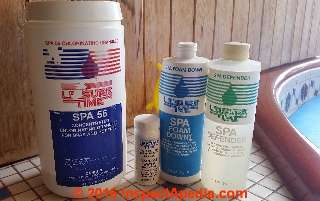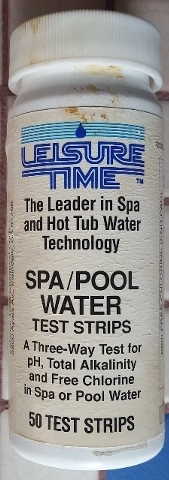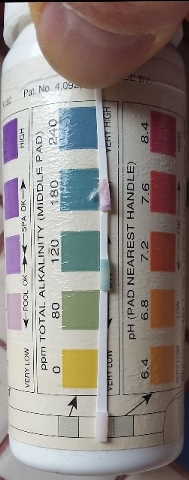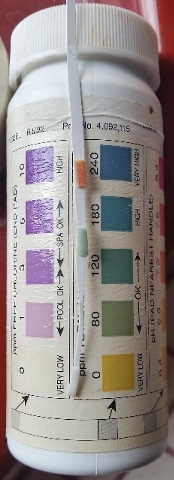 Hot Tub, Spa, Whirlpool Bath Chemicals
Hot Tub, Spa, Whirlpool Bath Chemicals
Guide to hot tub water treatment, disinfection, chlorine or bromine
- POST a QUESTION or COMMENT about how to troubleshoot & fix hot tubs, whirlpool bath tubs, spas, jacuzzis
Hot tub & spa or whirlpool bath chemical & water treatment guide:
Here we provide a simple table showing how to use chlorine or bromine and other chemicals & treatments to maintain a hot tub or spa, We explain how to use simple test strips to test the level of chlorine, bromine, pH, alkalinity, hardness and other spa or hot tub water properties in order to maintain a safe, sanitary hot tub or spa.
InspectAPedia tolerates no conflicts of interest. We have no relationship with advertisers, products, or services discussed at this website.
- Daniel Friedman, Publisher/Editor/Author - See WHO ARE WE?
Hot Tub / Spa Water Chemistry Recommendations
At the top of this page we illustrate the typical chemicals and pool or spa water test strips needed to maintain a hot tub or spa. After the table of recommended hot tub or spa water chemical levels given just below, we include examples of using test strips to measure these hot tub or spa water chemistry levels / numbers.
Hot Tub or Spa Water Chemistry Guidelines |
|||
Recommended Pool Chemical Hot Tub / Spa Water |
Recommended Level | Action to Correct Pool Water Chemistry |
|
| To Raise the Level | To Lower the Level | ||
pH & Alkalinity for Hot Tubs & Spas |
|||
pH pH measures the acidity or alkalinity of a solution where 7 is neutral, lower numbers are acidic and higher numbers are basic. |
7.2 - 7.83b | Add Soda Ash Add pH increaser product |
Add "dry acid" product Add pH decreaser product Add Muriatic Acid or Sodium Bisulphate Watch out: acids can cause dangerous burns or other personal injury and can be fatal if ingested. Be sure to follow the manufacturer's instructions. |
Total Alkalinity (TA level) Alkalinity measures the ability of water to neutralize an acid. |
50 ppm 3b 80-120 ppm (most-common) 100 - 130 ppm3a |
Add Bio-Guard or similar product Add Soda Ash Add Sodium Bicarbonate |
Add "dry acid" product Add Muriatic Acid |
Water Hardness or Calcium Hardness (CH level) 3b Water hardness measures the amount of mineral salts, chiefly calcium (Ca) and magnesium (Mn) dissolved in water. Harder water has higher levels of these salts. |
150 -250 ppm | Add a calcium / water hardness increaser Watch out: water that is too soft can damage hot tub or spa equipment by corrosion of metal parts. |
Add a water softener or calcium decreaser or stain & scale product or similar water conditioner Watch out: hard water (too high in calcium or magnesium) clogs equipment, particularly hot water piping & heating equipment and can damage pumps, valves, controls in a hot tub or spa. |
...
Chlorine Treatments for Hot Tubs & Spas |
|||
| Chlorine (Un stabilized) 1 | 0.3 - 1.0 ppm chlorine | Add Chlorine chemical | Wait - chlorine will naturally dissipate |
| Chlorine (Stabilized)3a | 1.0 - 3.0 ppm chlorine | Add Chlorine chemical | Wait - chlorine will naturally dissipate |
| Chlorine (Free chlorine)3b | 1 - 3 ppm chlorine | Add Chlorine chemical | Wait - chlorine will naturally dissipate |
| Chlorine stabilizer (Cyanuric acid) |
40 - 70 ppm chlorine | Add Stabilizer | Dilution - partially drain and refill the hot tub or spa with water that has not been treated with Cyanuric Acid. |
| Chlor Brite type shock treatment | 10 ppm free chlorine FC | Add Chlorine chemical | Wait - chlorine will naturally dissipate |
| Algae control 2 | Keep chlorine level at 0.5 ppm or above at all times. | See notes | Wait - chlorine will naturally dissipate |
...
Bromine5 Treatments for Hot Tubs & Spas |
|||
| Initial Bromide shock treatment / reserve: | 10 ppm bromine Watch out: do not enter the hot tub until the bromine level is below 10 ppm Weekly hot tub non-chlorine shock treatment is required |
Add sodium bromide + a shock oxidizer. Because bromine tablets may take a long time to dissolve, either crush the tablets or use a powdered sodium bromide product. | |
| Bromine level for hot tub use | 2-6 ppm bromine |
Add bromine tablets or use a bromine dispenser and oxidizer | |
| Weekly Bromine System Hot Tub / pa Maintenance: | Add 2-3 non-chlorine shock tablets formulated for use in bromine systems with pump and jets running for at least 15 minutes; test bromine, pH, and alkalinity levels. Adjust alkalinity and bromine as needed. Some sources3b suggest using un-scented laundry bleach at 1 cup of laundry bleach (5.25% concentration sodium hypochlorite) per 250-300 gallons of water, or 3/4 cup of "super bleach" (6% concentration) for the same water volume. | ||
Notes to the tables above
Watch out: keep all spa chemicals & treatments out of reach of children. Some of these can cause fatal poisoning or serious burns.
Watch out: hot tub or spa chemical treatment and water chemistry level requirements are different from those of a typical swimming pool. That is principally because the hot tub water is frequently heated to a much higher temperature. Do not assume that chemical treatments formulated for use in swimming pools are also suitable for use in hot tubs or spas.
1. Disinfectant: Chlorine or Bromine level for hot tub: Both chlorine and bromine are disinfectants commonly used in hot tubs and spas. Chlorine treatment generally costs less but requires more frequent dosing. The combination of heating and aeration of hot tub or spa water means that both of these chemicals will dissipate rapidly, but chlorine dissipates more rapidly than bromine. For the specific hot tub / spa described in the article above, local experts recommended the following:
- Chlorine maintenance level: between 1.5 - 2.0 ppm
- Check the chlorine level daily
- Shock level for initial treatment when you are first filling or re-filling a hot tub or spa is needed, and shock treatment may also be needed in your hot tub if problems are observed. In general shock treatment of a hot tub means that you temporarily increase the chlorine level to 3 x the above recommended levels. Or you may elect to use a special hot tub di-chlor chlorine shock treatment product. Leslie's Chlor Brite, a shock treatment product, recommends that you add that product until the chlorine level is at about 10 ppm of free chlorine (FC).
2. For controlling algae, look for green "blooms" of algae in the pool or hot tub water. Algae may be killed-off by shocking or "super-chlorinating" the pool by adding un-stabilize chlorine. Follow the manufacturers' recommendations. Algae control chemicals are available from your pool or hot tub / spa supplier. Algae that has been killed by chlorination may be removed by the hot tub or spa filter but it's likely that you'll then need to remove and clean the filter cartridge.
3.a. The table above is excerpted and adapted from the Hayward Pool Products Star-Clear filter manual PDF whose link is included in the references at the end of this article or found online at https://InspectAPedia.com/plumbing/StarClear_Filter_Manual.pdf This is general advice. Your local hot tub or spa consultant or manufacturer may have different recommendations specific to the water chemistry and properties where you live.
3.b. Additional table data is adapted from other hot tub treatment products such as Chlor BriteTM and troublefreepool cited below.
4. Minimum daily hot tub / spa operation & chemical testing: typical spa / hot tub instructions require that the spa pump and filter system be operated at least 2 hours / day even if you are not using the system. For details
see Spa Preparation & Maintenance, A Complete Spa Care Guide, Spa Water Testing, Spa Chemical Program, Spa Cleanup [PDF],
Leisure Time Chemical Corporation, Irwindale CA 91707. (1984) This company also provides a Hot Tub / Spa operating manual with recommendations for water and chemical maintenance. Website: www.leisuretimespa.com, this spa guide was provided at the original installation of the hot tub discussed in this article series.
5. Bromine: Sodium bromide used as a hot tub or spa sanitizer. Bromine tablets used in spas and hot tubs often contain both bromine and chlorine The chlorine serves as an oxidizer needed to active the bromine sanitizer.
- In a two-step hot tub bromine treatment process, bromine tablets are added to reach the required concentration of bromine in ppm and then an oxidizer is added weekly
- In a three-step hot tub or spa bromine treatment process (an alternative to the two-step method), additional bromine tablets are added in a floating dispenser to keep the bromine level constant.
Hot Tub / Spa Chemical Test Strip Examples
Above: Leisure Time Spa / Pool water test strips indicate water pH, Alkalinity and Free Chlorine as we illustrate successively below.
Watch out: if your pool or hot tub / spa water test strips are quite old, they may no longer be accurate. Buy a new set.
Above: pH test showing a pH between 6.8 and 7.2.
Below: spa, hot tub or pool water alkalinity test.
Above, the alkalinity test indicates an alkalinity between 80 and 120 ppm.
Below: using a test strip to test for free chlorine. The bottom-most or nearly-white indicator shows that the free chlorine in the water tested was very low. The target chlorine level is 1.5 - 2.0 ppm for the hot tub illustrated in this article series.
Above: the nearly-pure-white result of the bottom-most indicator tab on this test strip indicates almost no free chlorine in the water. This hot tub needs more chlorine added to its water.
Should You Use Ozone as an Oxidizer in Hot Tubs, Spas & Swimming Pools?
Probably not.
The use of ozone (O3) has been promoted by some spa, hot tub and swimming pool equipment & supply producers or vendors as an oxidant or oxidizing agent useful to improve water quality by removing " non-living bather waste such as body oils, cosmetics, sun tan lotions, perspiration, urine."
Watch out: Wojtowicz (2001) reports that in general ozone is ineffective for this application and that in any event it should not be used by methods that might expose the hot tub, spa, or pool users to elevated levels of ozone. That author also found that other claims of the benefits of ozone use in hot tubs and spas were not substantiated.
Ozonating the water while the spa is in use is not recommended because the unabsorbed ozone in the ozonator vent gas can amount to 60 ppm. - (Wojtowicz 2001 p. 147)
A number of UV ozonators have been evaluated and found to be unsuitable for pool or spa use. Although UV ozonator manufacturers typically claim lower chlorine consumption (typically 60 to 90%) and the ability to operate pools and spas at lower chlorine concentrations, no independent data are provided to support these claims. (Wojtowicz 2001)
Details about using ozone to improve water quality in spas, hot tubs, spas, or swimming pools are
at OZONE in HOT TUBS, SPAS, POOLS
Separately at OZONE HAZARDS readers will find a series of articles about both successful and un-successful, even dangerous applications of ozone.
Also see OZONE GAS EXPOSURE EFFECTS.
...
Continue reading at HOT TUB SPA WHIRLPOOL OPERATION & REPAIR - topic home, or select a topic from the closely-related articles below, or see the complete ARTICLE INDEX.
Or see these
Recommended Articles
- HOT TUB SPA WHIRLPOOL OPERATION & REPAIR
- SPA TURN ON PROCEDURE
- SPA CONTROLS & SWITCHES
- SPA / HOT TUB BLOWER UNIT
- SPA / HOT TUB FILTER CLEANING
- SPA / HOT TUB FILTER LEAK REPAIR
- SPA / HOT TUB FILTER REPLACEMENT
- SPA / HOT TUB HEATER REPAIR
- SPA, HOT TUB, SWIMMING POOL INSPECTION & CODES
- SPAS, WHIRLPOOLS, INSTALLATION
- SPA / HOT TUB JET CLOG REPAIR
- SPA / HOT TUB LEAKS
- SPA / HOT TUB & POOL OZONE
- SPA / HOT TUB PUMP OPERATION
- SPA / HOT TUB PUMP REPAIR
- SPA JETTED TUBS NOISE
- SPA HOT TUB WHIRLPOOL REPAIRS
- SPA / HOT TUB CHEMICALS & CHLORINATION
- SPA / HOT TUB DRAIN / WINTERIZING PROCEDURE
- SPA / HOT TUB / POOL MANUALS, PARTS, REPAIR, SUPPLIES
- SCALD PROTECTION
Suggested citation for this web page
SPA / HOT TUB CHEMICALS & CHLORINATION at InspectApedia.com - online encyclopedia of building & environmental inspection, testing, diagnosis, repair, & problem prevention advice.
Or see this
INDEX to RELATED ARTICLES: ARTICLE INDEX to BATH & KITCHEN
Or use the SEARCH BOX found below to Ask a Question or Search InspectApedia
Ask a Question or Search InspectApedia
Try the search box just below, or if you prefer, post a question or comment in the Comments box below and we will respond promptly.
Search the InspectApedia website
Note: appearance of your Comment below may be delayed: if your comment contains an image, photograph, web link, or text that looks to the software as if it might be a web link, your posting will appear after it has been approved by a moderator. Apologies for the delay.
Only one image can be added per comment but you can post as many comments, and therefore images, as you like.
You will not receive a notification when a response to your question has been posted.
Please bookmark this page to make it easy for you to check back for our response.
IF above you see "Comment Form is loading comments..." then COMMENT BOX - countable.ca / bawkbox.com IS NOT WORKING.
In any case you are welcome to send an email directly to us at InspectApedia.com at editor@inspectApedia.com
We'll reply to you directly. Please help us help you by noting, in your email, the URL of the InspectApedia page where you wanted to comment.
Citations & References
In addition to any citations in the article above, a full list is available on request.
- OZONE EXPOSURE STANDARDS
- OZONE for WATER DISINFECTION
- ANSI/NSPI–4 1999 Standard for Aboveground/ Onground Residential Swimming Pools
- ANSI/NSPI–5 1995 Standard for Residential Inground Swimming Pools
- Eichelsdorfer, D. and J. Jandik, “Long Contact Time Ozonation for Swimming Pool Water Treatment”, Ozone Science and Engineering 7(2)(1985):93-106
- Eichelsdorfer, D., “Use of Ozone for Treatment of Swimming Pool Water”, in Ozone Treatment of Waters for Swimming Pools, R. Rice, Ed., International Ozone Association, Norwalk, CT, 1982, pp. 82 and 91.
- Kon, Deborah, "Ozone in Your Pool and Spa", [Web article] Ultra Pure, 1175 Appleby Line
Burlington ON L7L 5H9
Tel:: 877 281-7603
Website: www.waterquality.net
Deborah Kon is the laboratory manager at UltraPure Water Quality Inc, a manufacturer of Ozone generators for residential pools and spas.
retrived 20167/03/22, original source: http://www.waterquality.net/upload/fmarticleso/Ozone_In_Your_Pool_Spa_13.pdf - Kinman, R.N., Water and Wastewater Disinfection with Ozone”, Critical Reviews of Environmental Control, 5(1975):141-152
- Tiefenbrunner, F., “Problems with the Direct Ozonation of Swimming Pool Water”, in Ozone Treatment of Waters for Swimming Pools, R. G. Rice, Ed., International Ozone Association, Norwalk, CT, 1982, p. 152.
- Wojtowicz, John A. "Use of ozone in the treatment of swimming pools and spas." [PDF] Journal of the swimming pool and spa industry 4, no. 1 (2001): 41-53. Retrieved 2016/03/22, original source: http://jspsi.poolhelp.com/articles/jspsi_v4n1_pp41-53.pdf
- Best Practices Guide to Residential Construction, by Steven Bliss. John Wiley & Sons, 2006. ISBN-10: 0471648361, ISBN-13: 978-0471648369, Hardcover: 320 pages, available from Amazon.com and also Wiley.com. See our book review of this publication.
- Best Practices Guide to Residential Construction, by Steven Bliss. John Wiley & Sons, 2006. ISBN-10: 0471648361, ISBN-13: 978-0471648369, Hardcover: 320 pages, available from Amazon.com and also Wiley.com. See our book review of this publication.
- In addition to citations & references found in this article, see the research citations given at the end of the related articles found at our suggested
CONTINUE READING or RECOMMENDED ARTICLES.
- Carson, Dunlop & Associates Ltd., 120 Carlton Street Suite 407, Toronto ON M5A 4K2. Tel: (416) 964-9415 1-800-268-7070 Email: info@carsondunlop.com. Alan Carson is a past president of ASHI, the American Society of Home Inspectors.
Thanks to Alan Carson and Bob Dunlop, for permission for InspectAPedia to use text excerpts from The HOME REFERENCE BOOK - the Encyclopedia of Homes and to use illustrations from The ILLUSTRATED HOME .
Carson Dunlop Associates provides extensive home inspection education and report writing material. In gratitude we provide links to tsome Carson Dunlop Associates products and services.





